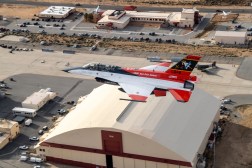Air Force wants ‘holistic’ solutions to improve data hygiene, harness AI

Newly confirmed Air Force Vice Chief of Staff Gen. Jim Slife has made leveraging data one of his top priorities — and he’s looking for industry’s help to improve how the service collects and exploits it.
Speaking to a crowd Thursday at a luncheon hosted by AFCEA, Slife outlined what he perceives as the Air Force’s biggest hurdles when it comes to taking advantage of data for operations, training, maintenance and more. By and large, he said most of the data collected by the Air Force is never tagged or analyzed and that many of its databases are segregated from one another, meaning the information can’t be used to create accurate, service-wide solutions.
“I know that many of the solutions to these things exist as point solutions. We need a more holistic approach to this,” Slife said. “It can’t just be, ‘vendor A’ and ‘product A’ solving ‘problem A’ — we need to think about our data and AI challenges holistically across the department.”
A large problem within the Air Force is that a lot of information captured “never sees the light of day” for several reasons — but mainly because the sheer amount of raw data makes it difficult to transmit and analyze by hand, Slife said. On top of that, stringent classification policies can impede who can access the data and where it can be used.
Slife pointed to the F-35 stealth fighter jet as an example. The aircraft collects terabytes of data from its radars, sensors, electronic warfare systems and communications equipment during each mission. But rather than have a way to collect the information and automatically categorize it for future use, the data is often deleted or written over, he said.
“There’s lessons learned built into that data. There’s the wingman that did the wrong thing, there’s the bad radio call, there’s the signal that we’ve never seen before,” Slife said. “We need that to incorporate it into our future missions, to train algorithms with the truth required for accurate AI models.”
Because the Air Force often lacks the network capacity to transport large amounts of data, the service copies information onto physical hard drives that are transported elsewhere. Even then, the data needs to be indexed by hand — a process that takes weeks, he added.
“When time runs short, we just frequently dump that data wholesale into the cloud somewhere — a so-called ‘data lake’ — and it’s unindexed data,” he explained. “These data lakes have more unusable data than that which is actually usable. These lakes, therefore, become ‘data swamps.’”
As the Air Force tries to get a handle on the huge amounts of data coming off newer platforms, it is also trying to find ways to access information from legacy systems, he said. Most of the service’s aircraft use a Military Standard 1553 data bus that manages and transmits all of the on-board information on a platform. That data could be used for mission reconstruction, identify failing parts, detect cyber attacks and more — but none of it is being recorded, according to Slife.
Another issue is that key data used by aircraft maintainers is spread across multiple databases owned by different organizations that do not communicate with each other, he said. These stovepipes prevent the Air Force from conducting accurate predictive analytics that could be used to keep legacy aircraft in the fleet longer.
“We have today all the data that we need to accurately predict aircraft part failures. But because it’s segmented and our databases don’t talk to each other, we’re just that much less effective,” he said. “Hospice care is the most expensive medical care, and we’re doing hospice care on much of our fleet.”
Slife said he plans to work with the Air Force’s Chief Data and Artificial Intelligence Office to address the service’s data inefficiencies.
He also issued a “call to action” for industry.
“Every bit of the data that we need to remain the best Air Force in the world is within our reach,” he said. “I’m not asking for a teleportation machine. I’m not asking for a flux capacitor. I’m not asking for anything that is beyond the realm of the possible. This is all within our reach, but we need innovative solutions to capture it, catalog it and classify it for us.”






